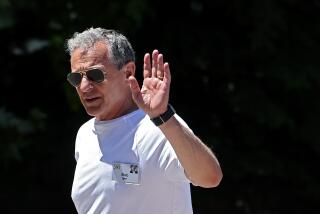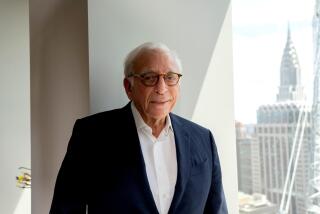Directors Are Forced to Sit in Hot Seat
One big company after another is melting down. Chief executives are being pushed out. Companies are under investigation. And now there’s another element to the turmoil in corporate boardrooms: More board directors are having to take over the CEO job for at least a while.
Interim chiefs are everywhere these days. The latest example is Daniel Dienstbier, president of Northern Natural Gas Co. and director of Dynegy Inc. The energy company, facing an investigation into its energy-trading business and accounting practices, Tuesday tapped Dienstbier as interim CEO to replace Chuck Watson, who resigned. Dynegy director Glenn Tilton, vice chairman of ChevronTexaco Corp., was named interim chairman
In the last two months, independent directors also were tapped to temporarily run CMS Energy Corp., cable company Adelphia Communications Corp., recreational vehicle builder Fleetwood Enterprises Inc., sportswear retailer Cutter & Buck Inc., discount retailer ShopKo Stores Inc. and clinical lab Specialty Laboratories Inc., to name just a few. A retired paper company executive has been interim CEO of United Airlines parent UAL Corp. for the last several months.
Charles King, head of director recruiting at executive search firm Korn/Ferry International, said as more CEOs are being let go by their boards, more outside directors are being tapped temporarily to take their places.
The prospect of becoming interim CEO is one more reason a boardroom seat is more taxing than ever for the roughly 60,000 independent and management directors of publicly held companies in the U.S. It’s still not like mining coal, but it’s not the cushy post it once was, either.
The collapse of energy trader Enron Corp. and accounting firm Arthur Andersen--and the serious problems at other companies such as Global Crossing Ltd., Qwest Communications International Inc., Kmart Corp. and Xerox Corp.--have put directors under growing pressure to tighten their governance.
A board of directors, typically between eight and 11 people, is supposed to oversee a company and its management, hire and fire the CEO and ultimately protect its shareholders’ interests. The members usually include two or three of the company’s top executives--such as the CEO, who often also is board chairman--with the rest being independent of the firm.
But the definition of “independent” also is under scrutiny. Many board members are lawyers or investment bankers whose firms do business with the company. Or the board might include the company’s retired CEO. So are they really independent members or actually “insiders”?
Either way, directors of all stripes are being excoriated, accused of being asleep at the switch as big corporations have faltered, wiping out billions of dollars of stockholders’ wealth. Board members of Enron, for instance, were brought to Capitol Hill along with Enron executives and harshly criticized by lawmakers for letting the fiasco unfold. The directors typically counter that they were misled or not informed by the companies’ managements. But it’s a defense many critics don’t buy, and calls for corporate governance reform are intensifying.
Even the board members’ trade group, the National Assn. of Corporate Directors, is urging the Securities and Exchange Commission and the nation’s stock markets to embrace a new set of governance principles for directors. Among them: that they more closely measure the performance of CEOs so that directors aren’t hit by ugly surprises.
“The burden of reform is on boards,” said the group’s president, Roger Raber. “And a lot more boards are going to be selective about who they bring on board.”
In turn, some directors think it’s no longer worth the trouble to serve, especially now that many are having to take CEOs’ reins because their companies are in dire trouble.
“More people are turning us down” for board seats, said M. Evan Lindsay, senior partner at executive search firm Heidrick & Struggles International Inc., involved in corporate board recruitment.
And running the show wasn’t in the basic job description. Although many boards are stacked with experienced CEOs of other firms, “most of them aren’t coming on [the board] to be the operator of the company,” said John Van de Kamp, a UAL director and former Los Angeles County district attorney.
Potential recruits interested in being directors are making more demands before they serve, including that the companies provide them with stronger liability insurance against civil lawsuits, Lindsay said.
Insurers, though, are hiking premiums and tightening coverage for directors in the wake of the scandals, lawsuits and government investigations of the last year.
Boards are the targets of institutional investors and bondholders, individual stockholders and their lawyers, union leaders, shareholder activists and federal and state regulators, all of whom are pressing directors to take more responsibility for their companies and securities prices.
This month, for instance, investors at UAL--which is 55% owned by its workers--used the airline’s annual meeting to push through a nonbinding proposal to separate the jobs of chairman and CEO to make those in the positions more accountable.
Shareholder activists for years have been prodding corporate managers and directors to do a better job of looking out for investors’ interests. But the pressure on them to act immediately to fix a problem--even if that means bouncing the CEO--is intensifying, especially with the economy and the stock market languishing, experts said.
So directors are more willing to show the chief executive the door, even if they don’t yet have a permanent successor inside the company.
“I don’t see it as boards having a trigger finger,” but they’ve gone from being “very slow in moving CEOs out” to being “more cautiously willing” to make the change, said Fran Conley, a director and recently named interim CEO of Cutter & Buck.
When directors of a company fire the CEO, “they don’t have all the information they’d like in order to select a new CEO,” even from within the company, so they pick a director to get a fresh assessment of the situation, Conley said.
“It seems to outweigh the negative of having two transitions” in the top job, she said.
All of this amounts to a huge change in what it means to have a board seat, a post that once was long on perks and short on demands. Directors--most of whom are white males over 50 and successful in their own right--still typically meet only six to eight times a year, for which they’re paid from $45,000 at small firms to $152,000 at the nation’s largest corporations, said Raber of the National Assn. of Corporate Directors. The compensation usually is divided between cash and the company’s stock.
Now, however, “the perceived risk [of being a director] is greater and the potential reward less in most people’s minds, the risk being the potential for litigation, embarrassment or even liability,” said Charles Elson, head of the Center for Corporate Governance at the University of Delaware.
As for the rewards, Korn/Ferry’s King said they are much more intangible.
“Most people serving on major corporate boards don’t need the money” because most board members “always have been and remain sitting CEOs” of other companies or are otherwise already wealthy, King said. “So more compensation isn’t going to persuade more people to sign up.
“The people who serve on these boards typically have spent their entire careers building two things: their professional reputation and their net worth,” King said. “And now a lot of directors are saying, ‘Yes, the rewards of board service are very nice, but I’m putting the two things I’ve worked 30 years for at risk.’”
So more directors also are looking much more carefully at directors’ and officers’ insurance coverages, said Lindsay of Heidrick & Struggles.
“In addition, they’re making sure that the company they’re considering ... has an impeccable record in terms of any kind of problems.”
But as Enron and so many other companies have shown this year, the problems often are invisible until they erupt into a scandal, leaving directors vulnerable to outrage and recrimination.
“I’ve been on boards, and sometimes the last ones to know things are directors,” Raber said.
That’s why more directors are much more circumspect about ensuring there is a climate of disclosure at the company they’re considering, he said.
And King predicted that a year from now, when most companies again elect directors at their annual meetings, there will be a larger than normal number of individuals who opt not to stand for reelection.
That’s fine with UAL’s Van de Kamp, even if it means one of his peers would have to take the CEO reins for a few months until the company is righted.
“Boards are under pressure and that’s a good thing,” Van de Kamp said. “Boards have the responsibility for the directions that their companies take. And the most important thing they do is hire the CEO.”
Raber said boards also will be adopting reform principles in the coming months.
“Instead of waiting for the SEC and institutional investors” to force them to change, “you’ll see more boards being more aggressive” about their duties, he said.
More to Read
Inside the business of entertainment
The Wide Shot brings you news, analysis and insights on everything from streaming wars to production — and what it all means for the future.
You may occasionally receive promotional content from the Los Angeles Times.











